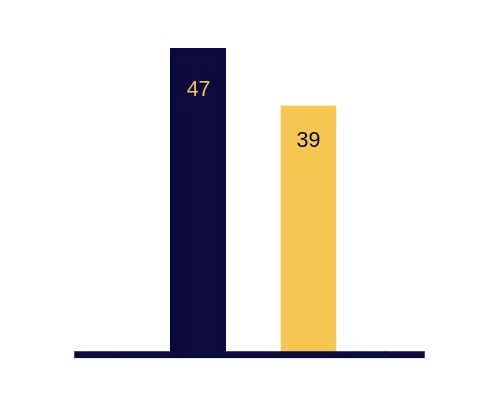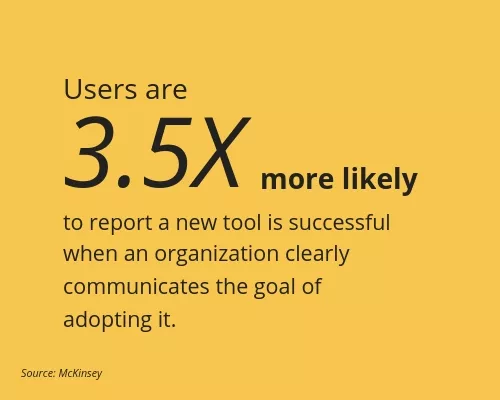The new software you implemented promised to boost productivity, employee engagement, and ultimately, revenue.
But it didn’t take long since you threw your team into the ring to realize your new digital tool isn’t sticking.
Your employees already have set routines and they are reluctant to dedicate time to learning something new. Some are still toggling back to your legacy system. Some are so frustrated by the complex interface and lack of familiarity on the new platform, they’ve resorted to completing processes manually.
It’s clear that you have a long way to go before your employees achieve digital adoption on your software investment.
But mapping a path to digital adoption is essential — you will only achieve the productivity and performance gains you invested in if your employees can use the technology in the way it was intended and to the fullest extent.
How to map the way to digital adoption
A survey by McKinsey found that the percentage of employees who believe their leaders regularly assess the ongoing impact of change efforts declined from 47% in 2014 to 39% in 2017. Treating software implementation as a one-and-done deal is a big mistake. Usability, productivity, and even the number of active users are important metrics to monitor on an ongoing basis.
Dive Deeper: Not Having a Digital Adoption Manager in 2019 Will Haunt You by 2020
Put bluntly, it will be impossible to achieve digital adoption without having some framework in place for assessing key metrics on the usability of the software. 
Your digital adoption strategy will guide you to achieve your goals. But you need to know how to measure digital adoption in order to understand if you’re on the right track.
Here are four steps for assessing if you’re on the right track to achieving digital adoption.
Step 1: Identify your baseline
With your current tools, how are you currently monitoring the success of your workforce? Start with baseline data and qualitative observations to get an accurate baseline understanding of how your technology is currently being used.
For example, imagine your organization is having difficulty with an influx of support tickets, so you’ve implemented a new tool to help them manage. Your support team has a set number of members who work eight hour days for five days per week.
Given these numbers, how long does it take for the support representative to solve each ticket and how many tickets can each member solve per week? This is your baseline data.
Baseline metrics provide a point from which you can begin mapping your digital adoption journey. When you fully understand the challenges that are blocking your from achieving digital adoption, you can plan your route around them.
An ROI calculator is an extremely helpful tool in figuring out these baselines. It uses industry statistics and averages on time or money spent on a business process to compute what your inefficiencies are costing the organization.
Step 2: Ensure all users understand the goals for the software
It is difficult to fully embrace any change without fully understanding why it must occur in the first place. 
If you want your employees to realize the full benefits of a digital tool, it’s critical to make sure they understand why those benefits are important — what is the goal you are using it to achieve?
When an organization clearly communicates the goals of a new initiative, users are 3.5 times more likely to report that the new tool is successful.
In our support ticket example, our objective is to increase productivity and save time. But your support staff will be reluctant to abandon familiar processes unless they understand how a new digital tool will help them achieve these goals. If they can’t make the connection, digital adoption will remain out of reach.
Step 3: Use quantitative and qualitative assessments
Now that you have your baselines and goals in place, it’s time to actually measure how far you are from digital adoption. While quantitative data can tell you exactly how far you are from your productivity goals, more general statements about your users’ experiences can be valuable as well.
Starting from the baseline, measure the distance between your current state and the desired goal. For instance, if your goal is to improve the productivity of your support desk, you will compare the average number of tickets each support employee handles a week to how many you’d like them to handle with the new software.
This is key to assessing digital adoption progress, as your employees will only achieve their productivity goals when they fully adopt the technology that is designed to enable them.
Qualitative statements are also valuable for measuring digital adoption. These measurements include survey results, focus groups, or even informal check-ins between employees and managers.
Ask your users how they feel that the platform is benefitting them, how easy it is to use and where they struggle. Getting qualitative responses can provide more thoughtful insight into your baseline data.
Step 4: Engage with a software solution that measures for you
Figuring out how to measure digital adoption can be challenging and time-consuming. But there is a simple solution — believe it or not, one of the best ways to measure the successful adoption of a digital tool is another digital tool.
With a digital solution that gives you a detailed look into the user journey, you can identify exactly where friction occurs, where users drop off, and which features are being underutilized. Based on that knowledge, you can tackle common user challenges and pave the way to digital adoption.
Understanding how to measure digital adoption not only lets you get the most from your software investments, it enables you to achieve core business goals. With metrics for evaluating digital adoption in place, you can ensure your users are on the track to success.
_________
WalkMe’s Digital Adoption Platform (DAP) transforms the user experience in today’s overwhelming digital world. Using artificial intelligence, engagement, guidance, and automation, WalkMe’s transparent overlay assists users to complete tasks easily within any enterprise software, mobile application or website. Discover how a DAP can revolutionize your business — request a demo today.

